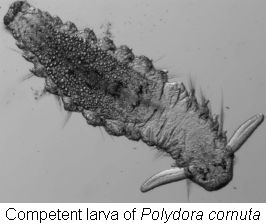
BioGeoChemistry of Tidal Flats
Colonization of tidal flats by benthic infauna
Is larval settlement guided by chemical cues?
The life cycle of the majority of benthic marine invertebrates includes a pelagic larval phase. Once larvae are transported to surfaces, the factors that guide the decision to accept or reject the microenvironment are complex and often interrelated. With particular emphasis on hard substrate fouling organisms research has shown that chemical cues (i.e. signaling molecules) induce attachment and metamorphosis in many benthic invertebrate species. Specifically surface-associated microorganisms, such as bacteria and diatoms, have been demonstrated to act as localized signposts in colonization patterns of barnacle and mussel larvae. These cues help to guide and place the organisms into suitable habitats that allow for increased reproductive success. Since surfaces can differ significantly in the marine environment, patchy distributions of benthic invertebrates are often caused by differences in surface chemistries.
The objective of Sub-Project 9 is to
- verify the existence of chemical signals that render larval settlement of dominant polychaete worms in mud flats
- chemically isolate and elucidate these target molecules for further studies
- understand their ecological context
Due to the high abundance of infaunal organisms in tidal flats of the Wadden Sea (i.e. 50 - 200k individuals m2 x 20 cm depth), the benthic infauna significantly impacts biogeochemical transformations in sediments and at the sediment-water interface. Thus, our studies complement the overall objective of the Research Group "Biogeochemistry of Tidal Flats" to fundamentally understand important processes in tidal flats.
 We currently characterize and compare bacterial community profiles on preferred and rejected sediment surfaces by molecular biological techniques, assess individual bacterial isolates on larval settlement, and try to correlate sediment attractiveness with the abundance of particular bacterial types. Moreover, we have established adult broodstocks of the spionid polychaetes Polydora cornuta and Streblospio elegans
We currently characterize and compare bacterial community profiles on preferred and rejected sediment surfaces by molecular biological techniques, assess individual bacterial isolates on larval settlement, and try to correlate sediment attractiveness with the abundance of particular bacterial types. Moreover, we have established adult broodstocks of the spionid polychaetes Polydora cornuta and Streblospio elegans for the continuous supply with larvae for bioassay purposes. The criteria of larval competence have been studied in detail and larval bioassays to qualitatively and quantitatively assess the efficacy of settlement cues have been developed. Having established this set of biological tools, the investigation of settlement cues in tidal flats of the Wadden Sea is currently under way.
for the continuous supply with larvae for bioassay purposes. The criteria of larval competence have been studied in detail and larval bioassays to qualitatively and quantitatively assess the efficacy of settlement cues have been developed. Having established this set of biological tools, the investigation of settlement cues in tidal flats of the Wadden Sea is currently under way.
| <<back | More details |